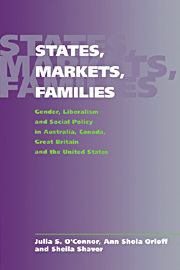 States, Markets, Families
States, Markets, Families Book contents
- Frontmatter
- Contents
- List of Tables
- Acknowledgements
- 1 Gendering Theories and Comparisons of Welfare States
- 2 Liberalism, Gender and Social Policy
- 3 The Labour Market and Social Policy
- 4 Social Rights Versus Gender Stratification and Gender Power?
- 5 Body Rights, Social Rights and Reproductive Choice
- 6 Liberalism, Gendered Policy Logics and Mobilisation
- 7 States, Markets, Families
- References
- Index
5 - Body Rights, Social Rights and Reproductive Choice
Published online by Cambridge University Press: 27 October 2009
- Frontmatter
- Contents
- List of Tables
- Acknowledgements
- 1 Gendering Theories and Comparisons of Welfare States
- 2 Liberalism, Gender and Social Policy
- 3 The Labour Market and Social Policy
- 4 Social Rights Versus Gender Stratification and Gender Power?
- 5 Body Rights, Social Rights and Reproductive Choice
- 6 Liberalism, Gendered Policy Logics and Mobilisation
- 7 States, Markets, Families
- References
- Index
Summary
The comparative study of welfare states has given surprisingly little attention to the role of the state in the sexual and reproductive lives of its citizens. This omission is particularly remarkable in such a long-standing, and nationally significant, area of public intervention in private life. Historically welfare states have concerned themselves with maternal and child health; with birth legitimacy and the moral character of the unwed mother; with natalism, eugenics and the peopling of the nation; and with the regulation of contraception, abortion, adoption, wet-nursing, homosexuality and incest. Maternal and child health and welfare services have their origins in the same period as the first old-age pensions and unemployment assistance, and were shaped in the same historical conditions of industrialisation and democratisation. Recent scholarship points to women's civic and religious movements as critical forces behind their development (Lewis 1980; Reiger 1985; Michel and Koven 1990).
The field is as fit as others for comparative inquiry. Like other social policy institutions, maternal and child health arrangements are historical constructions, differentially shaped by time and place, politics and culture. That the participation of women and women's groups in their development has been more active than in other social policy institutions might seem to suggest distinctive sources of variation among countries, and the possibility of types different from those based on social rights for workers, such as age pensions and unemployment insurance. However, there is also evidence that their contours may be similar.
- Type
- Chapter
- Information
- States, Markets, FamiliesGender, Liberalism and Social Policy in Australia, Canada, Great Britain and the United States, pp. 157 - 185Publisher: Cambridge University PressPrint publication year: 1999


